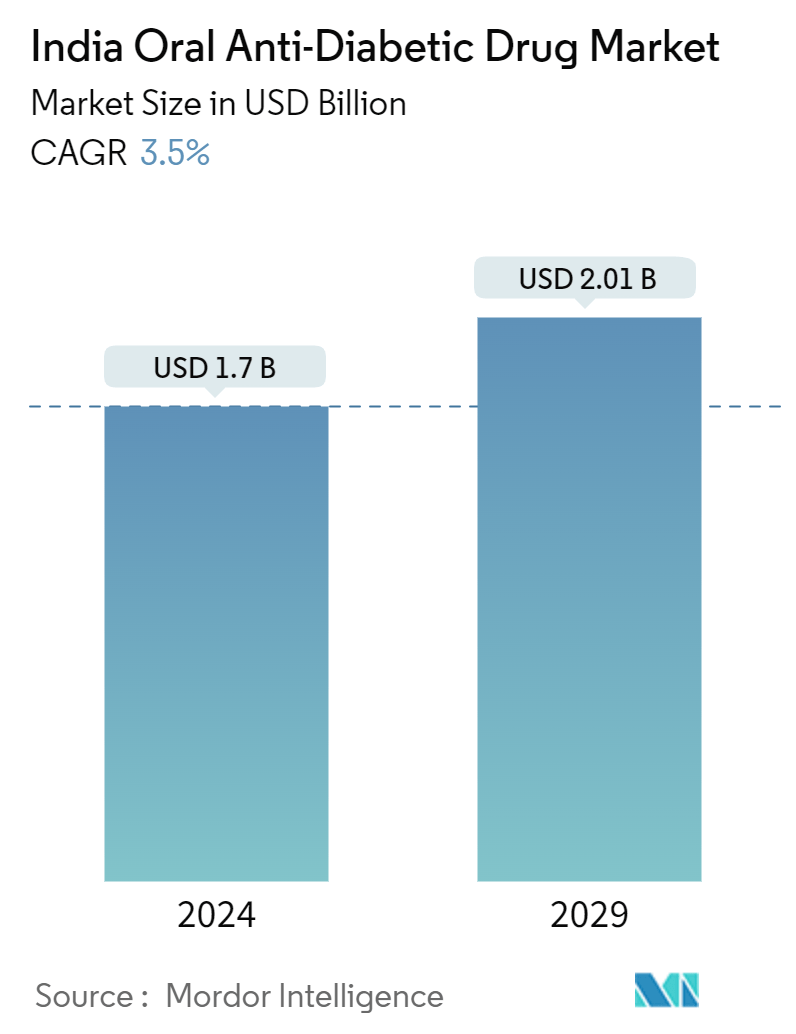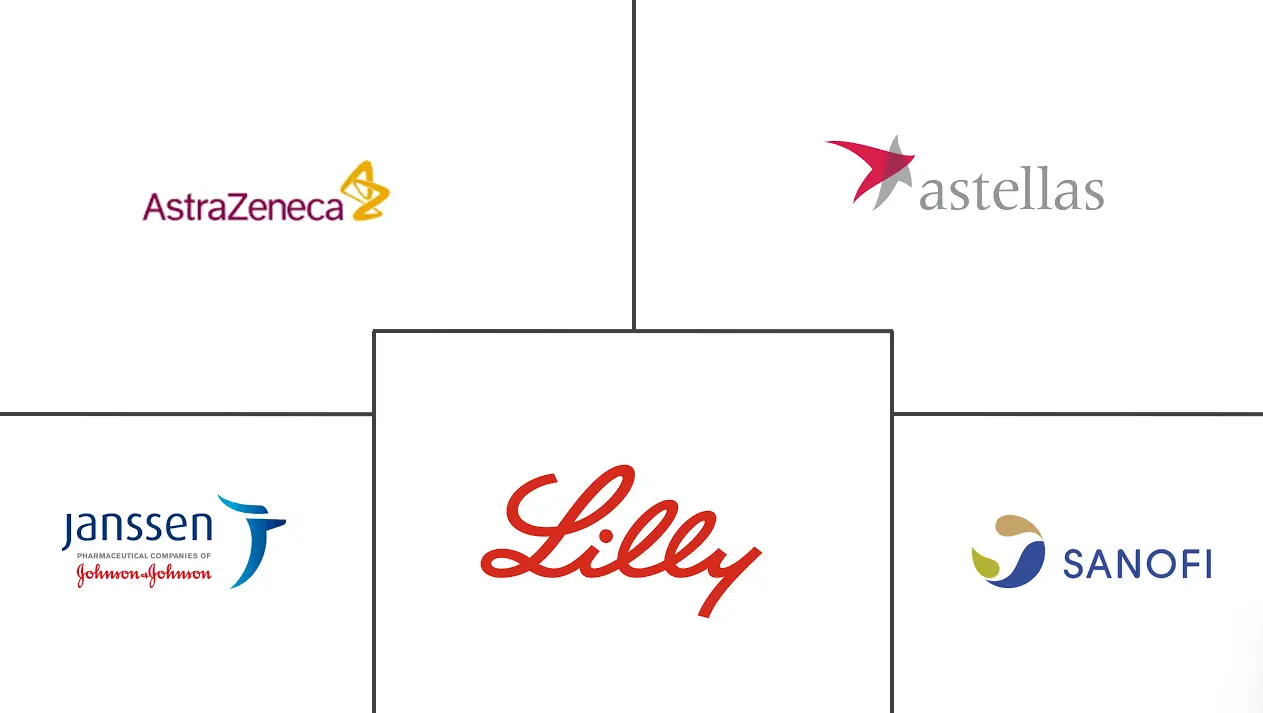Market Size of India Oral Anti-Diabetic Drug Industry

| Study Period | 2019 - 2029 |
| Base Year For Estimation | 2023 |
| Forecast Data Period | 2024 - 2029 |
| Market Size (2024) | USD 1.7 Billion |
| Market Size (2029) | USD 2.01 Billion |
| CAGR (2024 - 2029) | 3.50 % |
Major Players
*Disclaimer: Major Players sorted in no particular order |
India Oral Anti-Diabetic Drug Market Analysis
The India Oral Anti-Diabetic Drug Market size is estimated at USD 1.7 billion in 2024, and is expected to reach USD 2.01 billion by 2029, growing at a CAGR of 3.5% during the forecast period (2024-2029).
One in six people with diabetes worldwide, according to an article in "THE HINDU," is Indian. With an estimated 80 million diabetics, the country ranks second among the top 10 countries for those with the disease. In India, more than 50% of the population is at risk of developing diabetes at some point in their lives, making it a serious public health issue. Rural parts of India are also experiencing an increase in the incidence of type 2 diabetes.
After lifestyle changes, oral anti-diabetic medications play a significant role in the management of diabetes. Dipeptidyl peptidase 4 (DPP4) inhibitors and sodium-glucose cotransporter 2 (SGLT2) inhibitors are two novel medications that can be used alone or in combination with existing glucose-lowering medications, such as insulin, when diet and exercise alone are insufficient, and metformin is not tolerated. These drugs have different therapeutic, pharmacokinetic, and safety properties than the more established drugs.
Recently approved drugs like bromocriptine and hydroxychloroquine (hcq) have positive effects on blood sugar and HbA1C levels. Sulfonylureas (SU) were the only licensed insulin rivals until metformin was approved, and they were widely employed to treat T2DM. While there are now just three SU medications that can be prescribed.
India Oral Anti-Diabetic Drug Industry Segmentation
Orally administered antihyperglycemic drugs reduce blood glucose levels. Diabetes medications are employed to manage diabetes mellitus by reducing the glucose concentration in the bloodstream. Apart from insulin, the majority of GLP receptor agonists (such as liraglutide, exenatide, and others) and pramlintide are taken orally, earning them the name of oral hypoglycemic agents or oral antihyperglycemic agents. India's Oral Anti-Diabetic Drug Market is segmented into drugs. The report offers the value (in USD) and volume (in Units) for the above segments.
| Oral Anti-diabetic Drugs (Value and Volume, 2017 - 2028) | ||||||
| ||||||
| ||||||
| ||||||
| ||||||
| ||||||
| ||||||
|
India Oral Anti-Diabetic Drug Market Size Summary
The India Oral Anti-Diabetic Drug Market is poised for growth, driven by the increasing prevalence of diabetes in the country, which is home to a significant portion of the world's diabetic population. With a substantial number of individuals at risk, the market is witnessing a surge in demand for oral anti-diabetic medications. These drugs, particularly DPP4 and SGLT2 inhibitors, are becoming essential in managing diabetes, especially when lifestyle changes and traditional treatments like metformin are insufficient. The market is characterized by the introduction of novel medications and combinations, such as the recently launched triple-fixed-dose combination by Glenmark Pharmaceuticals, which highlights the ongoing innovation in this sector. The government's efforts to make diabetes medications more affordable and the active participation of major pharmaceutical companies further underscore the market's potential for expansion.
The market landscape is dominated by key players like Eli Lilly, AstraZeneca, Sanofi, and Janssen Pharmaceuticals, who are leveraging their global presence to influence the Indian market. The SGLT2 inhibitor segment is expected to lead the market, attributed to its dual benefits of lowering blood sugar and reducing the risk of hypoglycemia. The Indian government's National Health Program and the increasing public awareness about diabetes are creating opportunities for growth. As the country grapples with the economic burden of diabetes, both the government and pharmaceutical companies are focusing on developing innovative treatments and therapeutic solutions to address this pressing health issue.
India Oral Anti-Diabetic Drug Market Size - Table of Contents
-
1. MARKET DYNAMICS
-
1.1 Market Overview
-
1.2 Market Drivers
-
1.3 Market Restraints
-
1.4 Porter's Five Forces Analysis
-
1.4.1 Bargaining Power of Suppliers
-
1.4.2 Bargaining Power of Consumers
-
1.4.3 Threat of New Entrants
-
1.4.4 Threat of Substitute Products and Services
-
1.4.5 Intensity of Competitive Rivalry
-
-
-
2. MARKET SEGMENTATION
-
2.1 Oral Anti-diabetic Drugs (Value and Volume, 2017 - 2028)
-
2.1.1 Biguanides
-
2.1.1.1 Metformin
-
-
2.1.2 Alpha-Glucosidase Inhibitors
-
2.1.2.1 Alpha-Glucosidase Inhibitors
-
-
2.1.3 Dopamine D2 receptor agonist
-
2.1.3.1 Bromocriptin
-
-
2.1.4 SGLT-2 inhibitors
-
2.1.4.1 Invokana (Canagliflozin)
-
2.1.4.2 Jardiance (Empagliflozin)
-
2.1.4.3 Farxiga/Forxiga (Dapagliflozin)
-
2.1.4.4 Suglat (Ipragliflozin)
-
-
2.1.5 DPP-4 inhibitors
-
2.1.5.1 Onglyza (Saxagliptin)
-
2.1.5.2 Tradjenta (Linagliptin)
-
2.1.5.3 Vipidia/Nesina(Alogliptin)
-
2.1.5.4 Galvus (Vildagliptin)
-
-
2.1.6 Sulfonylureas
-
2.1.6.1 Sulfonylureas
-
-
2.1.7 Meglitinides
-
2.1.7.1 Meglitinides
-
-
-
India Oral Anti-Diabetic Drug Market Size FAQs
How big is the India Oral Anti-Diabetic Drug Market?
The India Oral Anti-Diabetic Drug Market size is expected to reach USD 1.7 billion in 2024 and grow at a CAGR of 3.5% to reach USD 2.01 billion by 2029.
What is the current India Oral Anti-Diabetic Drug Market size?
In 2024, the India Oral Anti-Diabetic Drug Market size is expected to reach USD 1.7 billion.

